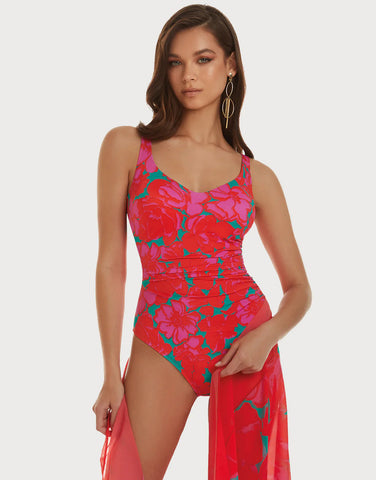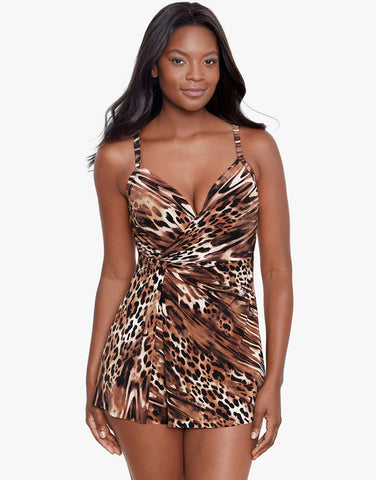Welcome to our Simply Beach guide on swimsuit materials! Today, we're diving deep into the fascinating world of swimwear fabrics to uncover the question: What are swimsuits made of?
We'll explore the best materials for beachwear, including polyester, nylon, elastane, and more. Plus, we'll look at the most popular swimsuit material in today's market.
As we navigate through the characteristics and eco-friendliness of these fabrics, we'll also share tips on what to look for when choosing your next swimsuit, including composition, weight, comfort, sustainability, and more.
What this article covers:- Common Types of Swimsuit Fabric
- Most Popular Swimsuit Material Today
- What to Look for in Swimsuit Material
Common Types of Swimsuit Fabric
Let's explore common fabrics used in swimwear today.
Polyester
As per our expertise at Simply Beach, polyester, a durable synthetic fabric, is often blended with other materials in swimsuits. This is done to enhance stretch and elasticity for a comfortable yet snug fit.
Its quick-drying properties make it perfect for beachgoers seeking seamless transitions from water to land.

Nylon
Nylon is another trendy synthetic fabric used in swimsuits because of its excellent strength and elasticity. It offers a smooth, lightweight feel against the skin, making it comfortable for extended wear.
Made from sustainable, recycled nylon, the Wonderland DD Drawstring Bandeau Swimsuit from Seafolly comes equipped with a hidden underwire for added chestal support and optional hip ties to increase leg height.
Elastane
Elastane, also called spandex or Lycra, is a stretchy synthetic fibre often fused with other fabrics in swimsuits.
It provides flexibility and shape retention, allowing swimwear to stretch with the body while maintaining a flattering fit for different body types.
Crafted with a robust blend of recycled Polyamide and Elastane, the Midnight Sounds Moulded Swimsuit from Charmline epitomises elegance and functionality.
Polybutylene terephthalate (PBT)
PBT is a chlorine-resistant type of polyester, ideal for swimwear worn frequently in pools. It maintains vibrant colours and shape even after prolonged exposure to chlorinated water, ensuring long-lasting support and vibrancy.
Natural fabrics
Some swimsuits are made from natural fabrics like cotton or bamboo, offering a soft, breathable feel ideal for sensitive skin or eco-conscious individuals.
Keep in mind that these materials may lack the durability and quick-drying properties of synthetics.
Neoprene
Based on our first-hand experience, neoprene, commonly used in wetsuits for cold-water activities, is now trendy in fashion-forward swimsuits for its texture and body-contouring properties.
These swimsuits offer thermal insulation and shaping, making them stylish choices for cooler climates or fashion-conscious beachgoers.
Each of these fabrics has its unique characteristics and advantages, catering to different preferences and needs.
Whether you're looking for resilience or fashion-forward designs, there are all kinds of swimsuit fabrics to suit your style and activity level.
Most Popular Swimsuit Material Today
Nylon and polyester are two of the most popular materials used in swimsuit production today, each offering unique characteristics and benefits.
Nylon
Nylon is widely favoured for swimwear because of its exceptional strength, elasticity, and lightweight feel, ensuring optimal comfort and flexibility during water activities.
Take, for instance, our Bel Air Modern Bandeau Swimsuit from Lauren Ralph Lauren, which boasts removable cups and optional neckties for personalised support and style.
Crafted from 83% Nylon and 17% Elastane, this swimsuit offers a flattering fit while retaining its shape and flexibility.
In the ongoing effort to promote sustainability, there's been a surge in using recycled nylon, derived from post-consumer materials like discarded fishing nets and plastic bottles.
Advancements in manufacturing have led to reduced water and energy consumption, contributing to a healthier environment.
At Simply Beach, we're committed to practising sustainable practices by offering swimsuits created from eco-friendly materials. Our beautifully curated Scallop Wide Strap Diagonal Swimsuit - Black epitomises this with the sleek and soft texture, made from 85% recycled nylon and 15% elastane.
Our Collective Cross Back Swimsuit - Mint is also a prime example of sustainability. It is made from 87% recycled nylon and 13% elastane. This piece also exudes elegance with its v-neck style.
Polyester
Polyester is prized in swimwear for its durability, resistance to wrinkles, and low-maintenance care.
Polyester swimsuits are also renowned for their fade resistance, preserving vibrant colours over time, while the smooth texture provides comfortable wear against the skin.
While traditional polyester production involves fossil fuel consumption and greenhouse gas emissions, efforts are currently underway to enhance polyester's eco-consciousness.
After conducting thorough research, we discovered that recycled polyester, made from post-consumer plastic waste, offers a greener option.
Improved production methods are also cutting resource use and waste, shaping a more sustainable future for polyester swimwear.
What to Look for in Swimsuit Material
When selecting the perfect swimsuit, it's essential to consider various factors that go beyond just style.
Composition
The combination of materials used in swimsuit construction significantly influences its performance and longevity. A well-balanced blend ensures elasticity, comfort, and resilience.
For example, the Sea Dive Cut Out Swimsuit from Seafolly, crafted from a fusion of nylon and elastane, offers both stretchiness and shape retention.
Weight
Opt for lightweight materials that provide ease of movement while swimming or engaging in beach activities.
These fabrics allow for effortless transitions between water and land, providing a hassle-free experience for all-day wear.
The Floreale Soft Cup Swimsuit from Roidal, for example, features soft cups and slight gathering to one side, providing a flattering and relaxed silhouette.
With its shaped neckline and classic Roidal scoop back, our findings show that it offers both fashion-forwardness and support for a day at the beach or by the pool.
Comfort
When choosing a swimsuit, we at Simply Beach recommend prioritising comfort for a satisfying experience.
Look for soft, smooth fabrics that feel gentle on your skin. Seek aspects like seamless construction and adjustable straps for a customisable, perfect fit.
Sustainability
In today's eco-conscious world, choosing environmentally friendly materials is crucial. Look for swimsuits made from recycled or sustainable fabrics, such as recycled nylon or polyester. These options help reduce waste and minimise the environmental footprint of your swimwear.
Quick Drying
Quick-drying fabrics are practical for swimwear as they minimise discomfort caused by prolonged wetness.
Materials like nylon and polyester excel in moisture-wicking properties, allowing you to stay dry and comfortable after exiting the water.
Fade Resistant
Fade resistance is essential for maintaining the vibrant appearance of your swimsuit. Fabrics treated with UV protection or specially formulated dyes resist fading from sun exposure, ensuring your swimsuit retains its colour and trendiness season after season.
Figure Flattering
When shopping for a swimsuit, prioritise materials with features that enhance your figure, such as compression and shaping properties.
Look for strategic seaming, ruching, and panelling that accentuates curves and offer targeted reinforcement where needed, helping you feel confident in your silhouette.
Take, for example, the Ocicat Adora Swimsuit from Miraclesuit, available at Simply Beach. We have found from using this product that it's crafted from Miratex fabric, providing all-over body control, shaping, and slimming effects.
It consists of under-wired soft cups and adjustable straps for customised support. Cleverly draped fabric helps conceal the tummy area, enhancing your overall look and boosting confidence.
Whether you're seeking comfort or style, knowing your swimsuit size is essential. By referring to our helpful guides on how to know your swimsuit size, you can shop with confidence and find swimwear that fits you perfectly.
Conclusion
In this article, we covered the most popular materials, as well as what to look for in a swimsuit material.
By weighing these factors and emphasising the qualities most important to you, you'll discover the ideal swimsuit tailored to your preferences, whether it's for poolside relaxation or embarking on seaside escapades.
Don't forget, for sourcing top-notch swimwear that seamlessly blends style and functionality, we at Simply Beach stand out as the best place to buy swimsuits for your upcoming beach excursion.
With an extensive collection crafted from premium materials, Simply Beach ensures you'll find the perfect swimming costume to elevate your beachwear wardrobe.
If you want to learn more, why not check out these articles below:
- What to Wear Under Swimsuit
- Where Can I Find Swimsuits in Winter
- How to Buy a One Piece Swimsuit
- Best Swimsuits
- Best Colour Swimsuit for Pale Skin
- Best Swimsuits for Swimming
- Best Swimsuit for Aqua Aerobics UK
- Best Black Swimsuits
- Best Swimsuits for Large Bust
- Best Swimsuits for Plus Size
- Best Swimsuits for Small Busts
- Best Swimwear for Over 60s
- Most Flattering Swimsuits Over 40 UK
- Best Swimsuits for Older Women
- Most Flattering Swimsuits for Over 50


